11 Best Carbon Offsets for E-Commerce (Complete 2025 List)
Affiliate Disclosure
Hey fellow impactful ninja ?
You may have noticed that Impactful Ninja is all about providing helpful information to make a positive impact on the world and society. And that we love to link back to where we found all the information for each of our posts.
Most of these links are informational-based for you to check out their primary sources with one click.
But some of these links are so-called "affiliate links" to products that we recommend.
Why do we add these product links?
First and foremost, because we believe that they add value to you. For example, when we wrote a post about the environmental impact of long showers, we came across an EPA recommendation to use WaterSense showerheads. So we linked to where you can find them. Or, for many of our posts, we also link to our favorite books on that topic so that you can get a much more holistic overview than one single blog post could provide.
And when there is an affiliate program for these products, we sign up for it. For example, as Amazon Associates, we earn from qualifying purchases.
What do these affiliate links mean for you?
First, and most importantly, we still only recommend products that we believe add value for you.
When you buy something through one of our affiliate links, we may earn a small commission - but at no additional costs to you.
And when you buy something through a link that is not an affiliate link, we won’t receive any commission but we’ll still be happy to have helped you.
What do these affiliate links mean for us?
When we find products that we believe add value to you and the seller has an affiliate program, we sign up for it.
When you buy something through one of our affiliate links, we may earn a small commission (at no extra costs to you).
And at this point in time, all money is reinvested in sharing the most helpful content with you. This includes all operating costs for running this site and the content creation itself.
What does this mean for me personally?
You may have noticed by the way Impactful Ninja is operated that money is not the driving factor behind it. It is a passion project of mine and I love to share helpful information with you to make a positive impact on the world and society. However, it's a project in that I invest a lot of time and also quite some money.
Eventually, my dream is to one day turn this passion project into my full-time job and provide even more helpful information. But that's still a long time to go.
Stay impactful,
E-commerce has seen significant growth in recent years, with the global e-commerce market crossing the $2 trillion threshold. But with all of this growth comes an increase in carbon emissions, which we must mitigate if we want to create a sustainable planet for future generations. Carbon offsets are one way to achieve this so, we had to ask: What are the best carbon offsets for e-commerce?
The best carbon offsets for e-commerce in terms of overall impact are EcoCart, Cloverly, South Pole’s Climate Click, and Stripe Climate. In addition, Cooler locks away carbon permits from the compliance market, and Carbonfund specializes in offsetting shipping costs.
Keep reading to learn more about the best carbon offsets for your e-commerce, how these carbon offset projects work, what their respective offsetting costs are, and what your best way would be to offset your carbon emissions. At the end of the article, we’ll also share with you what the biggest carbon offsetting limitations are and why reducing your carbon footprint is more effective than offsetting it.
Here’s What All the Best Carbon Offsets for E-Commerce Have in Common
Carbon offsets are reductions in carbon emissions that are used to compensate for carbon emissions occurring elsewhere. They are measured in tons of CO2 equivalents and are bought and sold through international brokers, online retailers, and trading platforms on what is known as the global carbon offset market.
“Carbon Offset: a way for a company or person to reduce the level of carbon dioxide for which they are responsible by paying money to a company that works to reduce the total amount produced in the world, for example by planting trees”
Oxford Dictionary
When you purchase carbon offsets, it’s important that they actually make a difference in total carbon emissions. To achieve that, the following are key criteria:
- Carbon offset projects have to be effective (different projects have different effectiveness rates)
- Carbon offset projects have to be additional
- Carbon offset projects have to be permanent
- The claims from carbon offset projects have to be verifiable
(For a full overview, check out our guide on how to choose carbon offset projects that actually make a difference.)
These Are the Best Carbon Offsets for E-Commerce in 2025
Below are our favorite carbon offsets for e-commerce:
| Carbon Offsets for E-Commerce | Quick Facts |
| EcoCart | About: A Google Chrome extension that automatically offsets the environmental impact of your online order when you shop with one of their partners. Funds offset projects including forest conservation, ocean cleanup, efficient cookstoves, and clean water filters. Cost for consumers: 1-2% of your cart total Cost for businesses: Free |
| Cloverly | About: A flexible API that calculates and neutralizes carbon emissions on a per-transaction basis by using inputs such as shipping weight and origination and destination postal codes, amongst others. Funds offset projects including improved forest management, solar power, landfill gas capture, energy efficiency, wind power, and avoided deforestation. Cost for consumers: Typically less than $1 per transaction Cost for businesses: Free |
| South Pole | About: South Pole’s Climate Click solution seeks to explore decarbonization pathways in various sectors. The money funds offset projects including renewable energy, reforestation, efficient cookstoves, and safe water. Cost for consumers: Pricing information can be obtained after initial contact Cost for businesses: Free, $99 per month, or $1,000 per year payment plans |
| Stripe Climate | About: Their Stripe Climate software allows businesses to contribute a percentage of their revenue to fund carbon removal projects vetted by Frontier. Cost for consumers: Free Cost for businesses: A fixed percentage of each transaction + standard Stripe fees (2.9% + 30 cents for every successful card charge). Customized plans are determined after initial contact. |
| Co2nsensus | About: An API that calculates the shipment-wise carbon emissions per product ordered online. Funds offset projects involving reforestation, wind energy, energy efficiency, landfill gas, biomass, and hydropower. Costs: Pricing varies depending on the details of the e-commerce purchases and the offset project selected. |
| ClimatePartner | About: Measure your businesses’ carbon footprint with an online calculator and then select a climate protection project to offset your emissions. The money funds biogas, clean cookstoves and drinking water, forest conservation, and renewable energy offset projects. Cost for consumers: Pricing information can be obtained after initial contact Cost for businesses: Pricing information can be obtained after initial contact |
| Carbon Checkout | About: A plug-in software application available for Shopify where the money funds carbon offset projects including wind farms and landfill gas capture. Cost for consumers: Pricing information can be obtained after initial contact Cost for businesses: Pricing information can be obtained after initial contact |
| Cooler | About: Available as an API or a plug-in software application that can be integrated ntegrated into Shopify or BigCommerce. they use the money to buy up carbon permits issued to businesses on the cap-and-trade compliance market in the United States. Cost for consumers: Approximately 0.5% the cost of any product or service Cost for businesses: 20% on top of the price of the carbon permits they purchase on your behalf |
| One Tribe Global | About: Connects businesses to rainforest protection charities so that every sale directly donates to and protects rainforests and the indigenous tribes and biodiversity that reside there. Cost for consumers: Pricing information can be obtained after initial contact Cost for businesses: Monthly plans starting at $9.80 plus offset costs |
| Simplizero Ecommerce | About: A plug-and-play solution that can be seamlessly integrated into every e-commerce platform. The money funds carbon offset projects including nature-based climate solutions, renewable energy projects and social projects contributing to clean energy transition in developing countries. Cost for consumers: Pricing information can be obtained after initial contact Cost for businesses: Pricing information can be obtained after initial contact |
| Carbonfund | About: Their Carbonfree Shipping Programsupports third-party validated and verified energy efficiency, forestry, and renewable energy carbon offset projects globally. Cost for consumers: $16.20 per 1,000kg of CO2 Cost for businesses: Pricing information can be obtained after initial contact |
EcoCart: An Eco-Friendly Option for Customers
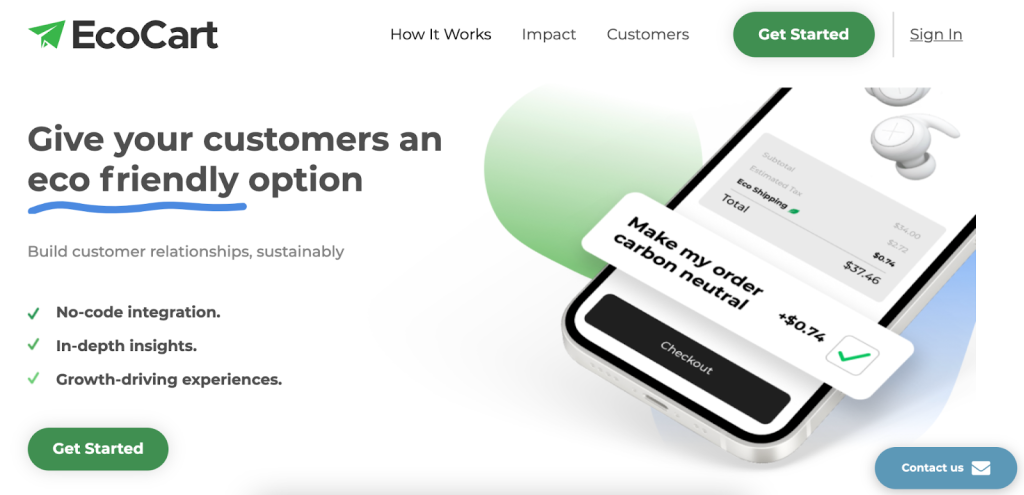
EcoCart is a Google Chrome extension that automatically offsets the environmental impact of your online order when you shop with one of their partners. They currently power a sustainable shopping experience for more than 1,000 brands including UTZ and Bark Box. To date they have offset nearly 29 million lbs of CO2 and saved 848 thousand trees. Their mission is to create a carbon neutral future.
“Build customer relationships, sustainably.”
EcoCart
Project overview: EcoCart’s functions in 3 simple steps: installing and customizing the EcoCart plug-in, calculating the manufacturing and shipping carbon footprint for each order via their algorithm, and providing the consumer the option to check a box to make their order carbon neutral (typically adding 1-2% to their total). The commission they earn from your purchase goes towards funding triple-verified projects including, but not limited to, forest conservation in Sierra Leone, ocean cleanup in Vietnam, efficient cookstoves in China, and water filters in Laos.
Carbon offset cost for consumers: EcoCart costs 1-2% of your cart total.
Carbon offset cost for businesses: EcoCart does not cost anything for your business.
Carbon offset effectiveness: EcoCart projects are legitimate, impactful, traceable, and transparent. They use the Verified Carbon Standard, Gold Standard, American Carbon Registry, United Nations Department of Climate Change, and Climate Action Reserve to help ensure transparency and quality in the creation, quantification, and verification of offset projects. Over 90% of each dollar goes towards these verified projects.
How to get your carbon offsets: If you are a business looking to partner with EcoCart, get started by contacting an EcoCart representative. And if you are a consumer, visit this webpage to download and install their Google Chrome plugin.
Cloverly: Sustainability on Demand

Cloverly is a company that neutralizes carbon emissions with their carbon offset software. They partner with reputable suppliers to connect carbon offset projects with the people and organizations looking to neutralize their carbon impact. Their mission is to neutralize carbon emissions around the world.
“Connecting the carbon offset infrastructure for a more sustainable world.”
Cloverly
Project overview: Cloverly is a flexible application programming interface (API) that calculates and neutralizes carbon emissions on a per-transaction basis by using inputs such as shipping weight and origination and destination postal codes, amongst others. Once installed and enabled, you will see a checkbox in your cart that displays the price to offset the carbon emissions from your online order. Commissions go towards a variety of carbon offset projects including improved forest management, solar power, landfill gas capture, energy efficiency, wind power, and avoided deforestation at locations around the world.
Carbon offset cost for consumers: You can make your online order carbon neutral for typically less than $1 per transaction. Contact Cloverly directly for further pricing information.
Carbon offset cost for businesses: Cloverly is free to use for businesses.
Carbon offset effectiveness: Cloverly carbon offsets are third-party verified by the Verified Carbon Standard, Gold Standard, and American Carbon Registry to help ensure transparency and quality in the creation, quantification, and verification of offset projects.
How to get your carbon offsets: You can either integrate Cloverly into your store’s cart experience through a custom integration, or simply download the Cloverly plugin for your Shopify or BigCommerce store. You can also contact their team for more information.
South Pole: The Climate Click Action Plugin For E-Commerce
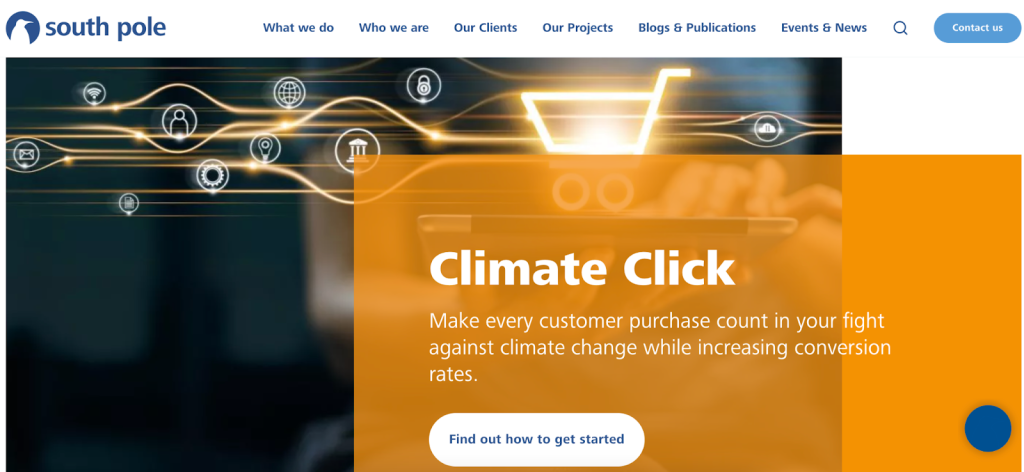
South Pole’s Climate Click, formerly known as CO2ok, is an ecommerce plugin that is an extension of South Pole. Their mission is to help businesses and governments acheive decarbonization across industries.
“Increase your conversion. Fight climate change.”
South Pole
Project overview: South Pole’s Climate Click plug-in software application (app) for e-commerce is available on all major e-commerce platforms and gives you the option to make your online purchase carbon neutral in one click. Their algorithm calculates the greenhouse gases emitted during production and transport, and consumers are charged a small fee upon purchase in order to fund carbon offset projects. South Pole has over 1,000 projects including nature-based solutions, community and clean water, renewable energy, waste to energy, and plastic solutions. For businesses, the money paid by your customers is added to their total at checkout and paid to you. These amounts include value-added tax and will be invoiced on an aggregated quarterly basis by South Pole.
Carbon offset cost for consumers: Contact South Pole to learn about the cost to the consumer.
Carbon offset cost for businesses: There is a free and premium version of Climate Click available for businesses. The premium version costs approximately $99 per month or $1,000 per year.
Carbon offset effectiveness: South Pole’s carbon offset projects adhere to the aims of the Paris Agreement and the UN Sustainable Development Goals. They are also third-party verified by the Verified Carbon Standard, Gold Standard, Climate Action Reserve, and The Clean Development Mechanism.
How to get your carbon offsets: Downloading and integrating South Pole’s Carbon Click plug-in into your e-commerce business can be done in minutes. It is free and available for Shopify, WooCommerce, and Magento.
Stripe Climate: A Complete Payment Platform for E-Commerce
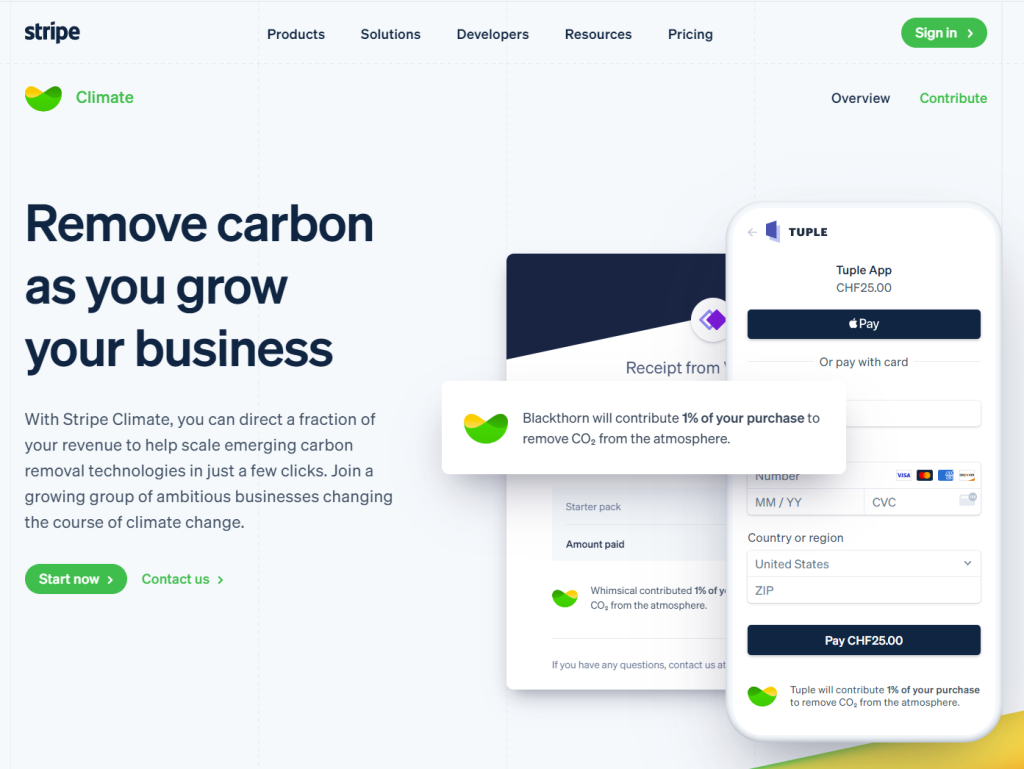
Stripe was founded in 2010 as an online payment and credit card processing platform for businesses. They launched their climate platform to allow businesses to fund carbon removal projects to combat climate change. Their mission is to make moving money simple, borderless, and programmable, just like the internet.
“Direct a fraction of your revenue to help scale emerging carbon removal technologies in just a few clicks.”
Stripe
Project overview: Stripe Climate is a software that allows businesses to contribute a portion of their revenue to fund carbon removal projects that are sourced and vetted by Frontier, an advance market commitment (AMC) that purchases carbon removal from suppliers to later resell. Stripe Climate businesses set up automatic contributions equaling a percentage of each transaction. For example, a 1% contribution program would see $1 out of every $100 funding carbon removal. Example carbon removal projects funded by Stripe Climate include direct air capture, enhanced weathering, and synthetic biology.
Carbon offset effectiveness: Stripe Climate carbon removal projects are vetted by Frontier, which chooses projects that store carbon permanently (>1,000 years), result in net CO2 reduction, are additional, and are verifiable.
Carbon offset costs for consumers: Free.
Carbon offset costs for businesses: The total cost is the transaction percentage plus standard Stripe fees. Businesses choose the percentage per transaction they want to contribute. Standard Stripe fees include 2.9% + 30 cents for every successful card charge for their integrated plan. Customized plans are determined after initial contact.
How to get your carbon offsets: You can visit the Stripe Climate webpage to learn more about the program and create an account to register your business. You can also contribute to Stripe Climate directly via donation.
Co2nsensus: A Climate-Tech Company
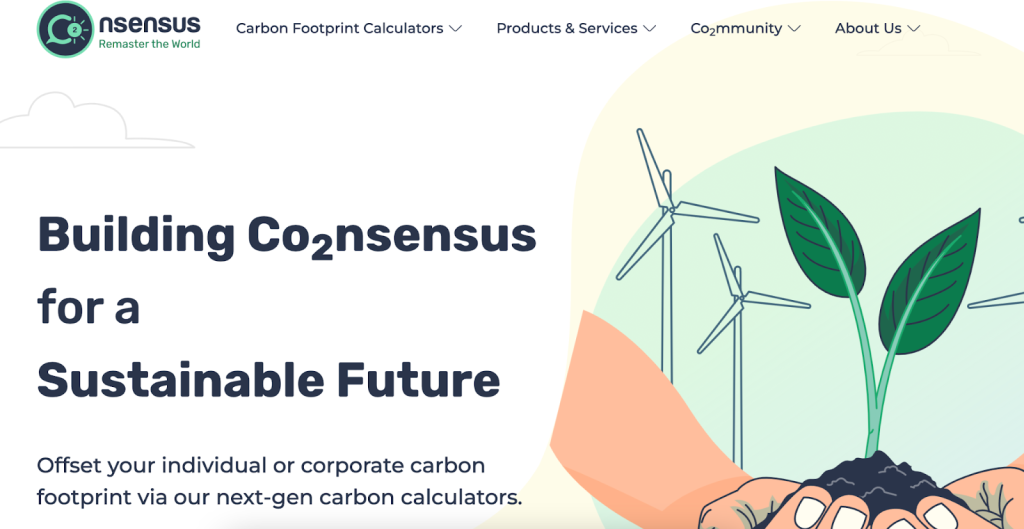
Co2nsensus was founded in 2019 by Bekir Cetin as a climate-tech company focused on helping individuals and businesses neutralize their carbon footprint. Today, they provide various carbon footprint calculators, carbon offsets for individuals, carbon management software, and a carbon-neutral e-delivery system for e-commerce.
“Building Co2nsensus for a Sustainable Future”
Co2nsensus
Project overview: Co2nsensus’ e-commerce solution, the Green Delivery API, calculates the shipment-wise carbon emissions per product and presents the customer with carbon offset projects they can fund offset their emissions. Purchases support carbon offset projects involving reforestation, wind energy, energy efficiency, landfill gas, biomass, and hydropower. Example projects include improved cookstoves in Kenya, hydroelectric power in Turkey, and reforestation in Uruguay.
Carbon offset effectiveness: Co2nsensus’ carbon offset projects are verified by the Gold Standard and Verra and contribute to UN Sustainable Development Goals.
Carbon offset cost for consumers: Costs are determined after initial contact.
Carbon offset cost for businesses: Costs are determined after initial contact.
How to get your carbon offsets: You can visit their website and contact a representative to get the Green Delivery API.
ClimatePartner: Your Partner for Climate Action
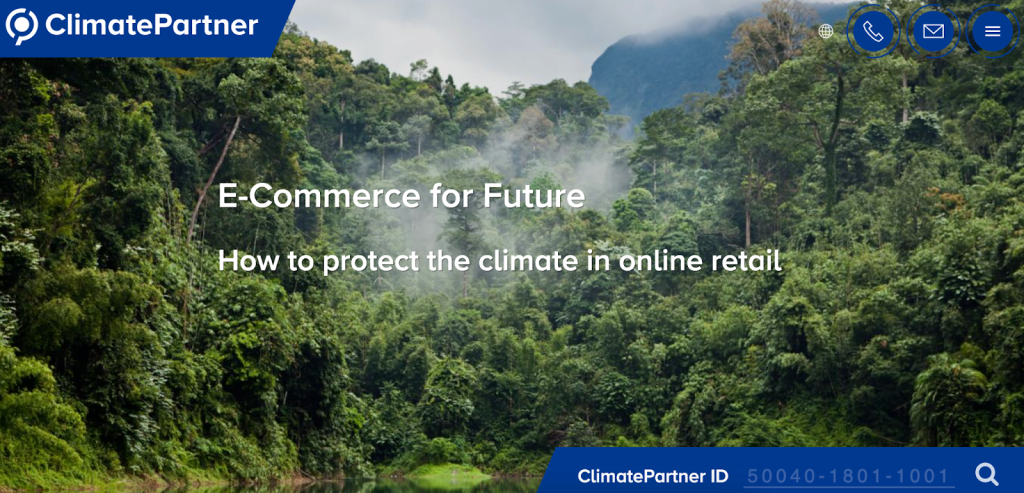
ClimatePartner is comprised of a multi-national team from 20 countries offering a variety of climate action solutions including carbon footprints, climate action strategies, carbon-neutral products, and carbon offset projects. With their e-commerce solution, you can help protect the climate in online retail. Their mission is to improve the living conditions of people, animals, and biosphere by taking ambitious climate action globally.
“Taking climate action, improving lives”
Climate Partner
Project overview: The ClimatePartner solution for e-commerce allows you to measure your businesses’ carbon footprint with an online calculator and then select a climate protection project to offset your unavoidable emissions. Upon partnering with them, you will receive the ClimatePartner label with your ID number, allowing you and your customers to trace the carbon offset. The money funds carbon offset projects globally including biogas, clean cookstoves and drinking water, forest conservation, and renewable energy.
Carbon offset cost for consumers: Pricing information can be obtained by contacting a representative.
Carbon offset cost for businesses: Pricing information can be obtained by contacting a representative.
Carbon offset effectiveness: ClimatePartner offsets are certified according to the highest international standards (Verified Carbon Standard, Gold Standard, and Plan Vivo) and are regularly inspected by independent organizations.
How to get your carbon offsets: Contact ClimatePartner to make your e-commerce business carbon neutral.
Carbon Checkout: Balance Your Carbon Footprint With One Click
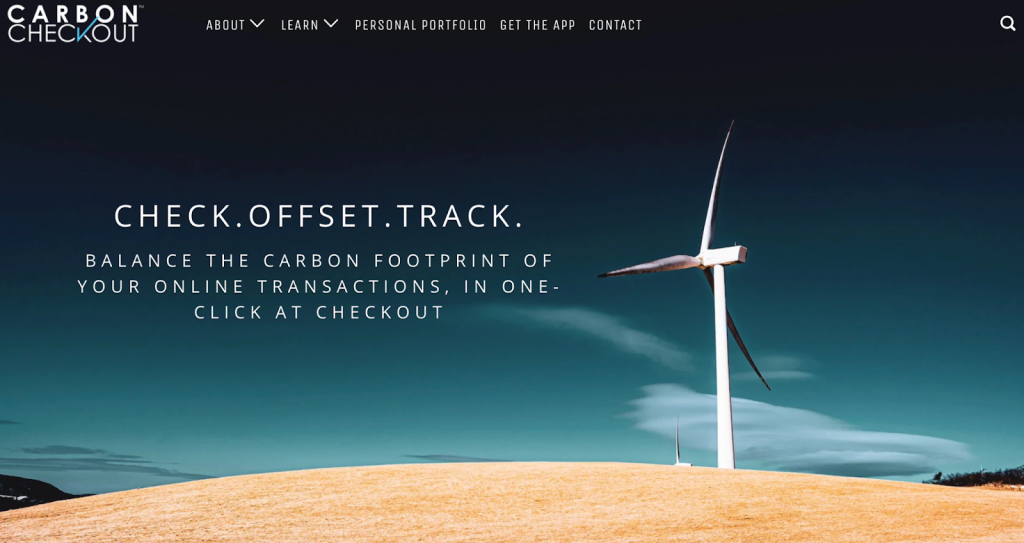
Carbon Checkout was first launched with Shopify back in 2015. It now spans 37 countries and has grown into one of the world’s largest carbon offset distribution networks. It and it’s 2,000+ e-commerce partners offer you the option to offset the carbon footprint of any purchase with one-click at checkout through the use of their app. Their mission is to build the future through renewables powered by Carbon Checkout.
“Check. Offset. Track.”
Carbon Checkout
Project overview: Carbon Checkout is a plug-in software application (app) that can be integrated into existing e-commerce stores. When you purchase from these stores, you then have the opportunity to offset the carbon footprint of your transaction. The app is free to download and use. For every $1 contributed, Carbon Checkout offsets 111kg (245 lbs) of CO2.
Commission goes towards renewable energy projects including wind farms in Latin America, Bulgaria, and South Dakota (US), and landfill gas capture in Virginia (US) and South Carolina (US).
Carbon offset effectiveness: Carbon Checkout projects are third-party verified by the Verified Carbon Standard, Gold Standard, Climate Action Reserve, and The Clean Development Mechanism to help ensure transparency and quality in the creation, quantification, and verification of offset projects.
Carbon offset cost for consumers: Pricing information can be obtained by contacting a representative.
Carbon offset cost for businesses: Pricing information can be obtained by contacting a representative.
How to get your carbon offsets: Visit the Shopify app store to install the Carbon Checkout app. Any questions can be directed to a member of Carbon Checkout’s team.
Cooler: Providing Multiple Integrations for E-Commerce

Cooler is an organization that has partnered with various businesses to help make their carbon neutral goals a reality. They have almost 20 years of experience, have processed $5 million dollars in transactions, and have eliminated over 1.8 million kg (2,000 tons) of carbon by buying up carbon permits on the cap-and-trade market. Their mission is to make businesses carbon neutral and match the growing demand for climate conscious companies.
“Make your business part of the climate solution.”
Cooler
Project overview: Cooler has taken a different approach to reduce CO2 emissions. First, they calculate the carbon footprint you sell and charges based on that footprint. Then, they use that money to purchase carbon permits issued to businesses on the cap-and-trade compliance market in the United States. Since the number of carbon permits is finite, this decreases the overall amount of CO2 that emitters are allowed to emit.
This approach is also used by Climate Vault, an organization that works with supporters, organizations, and individuals to reduce and eliminate carbon footprints. They were featured in one of our other articles, How to Buy Carbon Offsets That Actually Make a Difference (Complete 2022 List).
Carbon offset cost for consumers: Generally, it costs approximately 0.5% the cost of any product or service.
Carbon offset cost for businesses: Every month, you’ll receive an invoice for the cost of the carbon permits Cooler has purchased and retired in your name. Cooler’s total fee is 20% on top of the price of the carbon permits.
How to get your carbon offsets: Cooler can be integrated into Shopify or BigCommerce. It is also available as an API, which is currently available in private beta and only accessed by request.
One Tribe Global: Sell More Sustainably
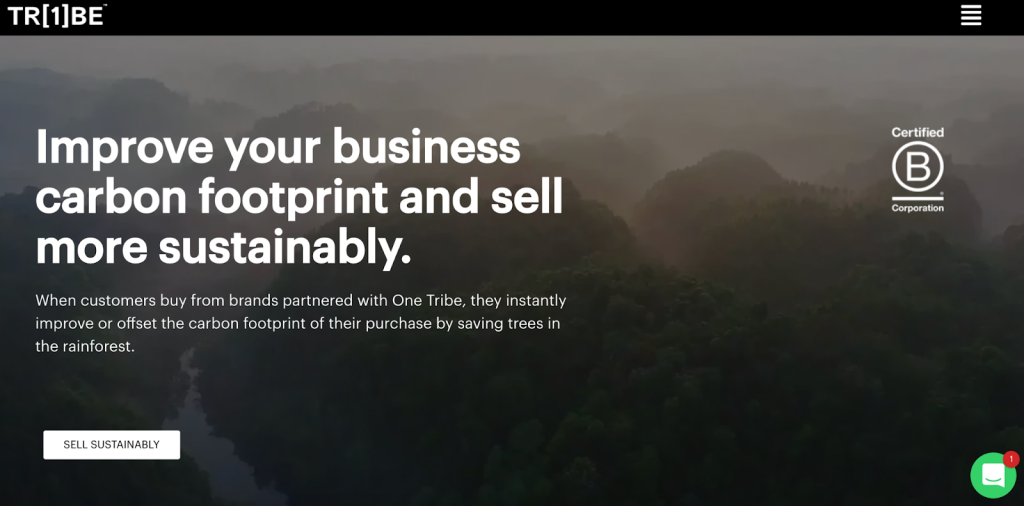
One Tribe Global was founded in 2019 as a Climate Action Platform comprised of environmentalists, technologists, and marketers that enables businesses and their customers to make a positive environmental impact and protect the lungs of planet earth. To date they have protected over 78 million trees, offset over 7 million tonnes of CO2, and saved over 100 thousand acres of rainforest. Their mission is to protect 1 billion trees and our planet for future generations by engaging global businesses in climate action.
“Improve Your Carbon Footprint & Attract More Eco-conscious Customers.”
One Tribe Global
Project overview: One Tribe connects businesses to rainforest protection charities so that every sale directly donates and protects rainforests and the indigenous tribes and biodiversity that reside there. Rainforest protection projects are currently occurring in the Republic of Congo, Sumatra, Bolivia, Brazil, Colombia, Peru, and Mexico. The amount of carbon offset through their partners in 2021 was equal to the yearly average emissions of 40.1 million cars.
Carbon offset cost for consumers: Pricing information can be obtained by contacting a representative.
Carbon offset cost for businesses: One Tribe offers 3 plans to make your business more sustainable available with no contract required.
- Starter: Approximately $9.80 per month. You can protect 5 trees for just $0.18 per sale.
- Growth: Approximately $53.30 per month. Number of trees protected and monetary value per sale varies.
- Enterprise: Pricing varies and is determined after booking a call. Number of trees protected and monetary value per sale varies.
Carbon offset effectiveness: One Tribe works with the United Nations Framework For Climate Change and the Rainforest Trust to fufill 6 of the SDGs and to help ensure transparency and quality in the creation, quantification, and verification of offset projects.
How to get your carbon offsets: You can visit their pricing plan webpage or book a call with a One Tribe representative before signing up.
SimpliZero Ecommerce: A Plug-and-Play Solution
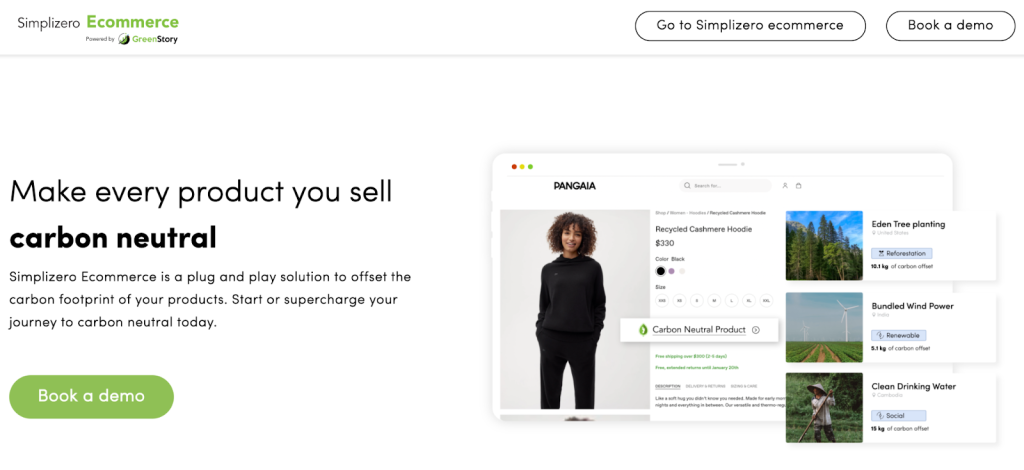
SimpliZero Ecommerce by Green Story is a Netherlands-based sustainability platform. It is a plug-and-play solution that can be seamlessly integrated into every e-commerce platform. They have analyzed over 2,000 supply chains in 35 countries and work with leading brands in the sustainability industry. Their mission is to empower 1 billion consumers to know their impact and make choices that are better for the planet and the generations to come.
“Make every product you sell carbon neutral”
SimpliZero
Project overview: Simplizero algorithms use the Global Standard of Life Cycle Analysis (LCA) to calculate the carbon footprint of your businesses’ products. You can offset your products’ carbon emissions at the wholesale level either by uploading your entire order and offsetting the order’s emissions by product name or product kg, or by offsetting by emissions quantity (tons). The money collected funds projects including nature-based climate solutions, renewable energy projects and social projects contributing to clean energy transition in developing countries.
Carbon offset cost for consumers: Pricing information can be obtained by booking a demo with a representative.
Carbon offset cost for businesses: Pricing information can be obtained by booking a demo with a representative.
Carbon offset effectiveness: Carbon offsets are fully transparent with zero markup. 100% of the money goes towards funding projects which are all vetted and third-party verified by Verra or the Gold Standard.
How to get your carbon offsets: Book a demo call with Simplizero to get more information about their carbon offsets.
Carbonfund: Go Carbon Neutral
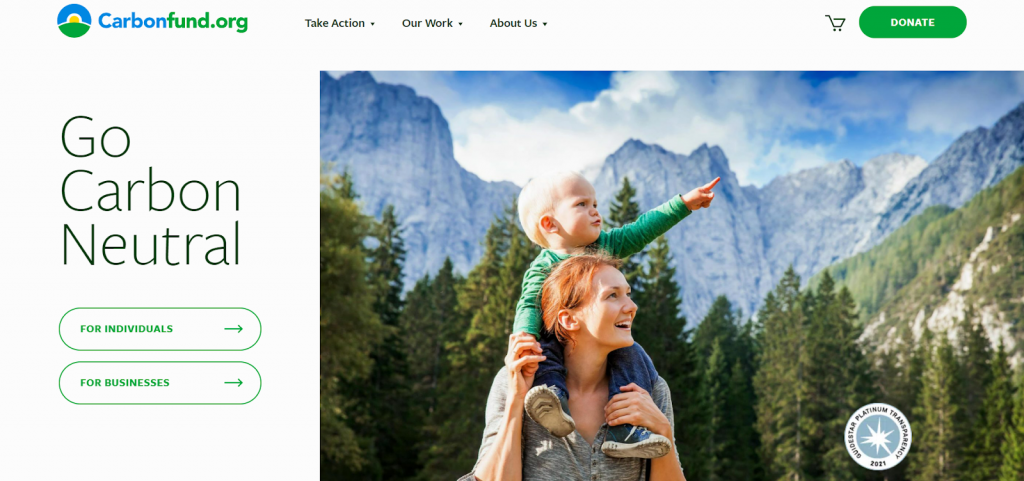
Carbonfund is a nonprofit organization founded in 2003 by current President Eric Carlson and is based in New York, United States of America. To date, they have supported 240 projects in 28 countries. Their mission is to make it easy for any individual, business, or organization to reduce & offset their climate impact and hasten the transition to a clean energy future.
“Reduce what you can, offset what you can’t”
Carbonfund
Carbon offset overview: Carbonfund offers an innovative and flexible way to help your business calculate, reduce and offset your carbon footprint, named the Carbonfree® Shipping Program. Product shipping emissions depend on the shipping mode (air, truck/ground, sea, etc.), the number of parcels shipped by each shipping mode, and the average weight and distance for those parcels. And you can use their Carbonfree® Shipping logo to promote your environmental commitment. Purchases support energy efficiency, forestry, and renewable energy carbon offset projects globally.
Carbon offset effectiveness: Carbonfund projects are third-party verified and adhere to the Verified Carbon Standard, Gold Standard, American Carbon Registry, and Climate Action Reserve.
Carbon offset cost for consumers: Approximately $16.20 per 1,000kg of CO2 offset.
Carbon offset cost for businesses: Pricing information can be obtained by contacting a representative.
How to get your carbon offsets: Visit their Carbonfree® Shipping Program webpage to learn more offset your business’s e-commerce carbon footprint. And use their carbon footprint calculator for shipping to offset your emissions.
How to Choose Carbon Offset Projects Actually Make a Difference
The following information is a summary for you based on our full guide: “How to Buy Carbon Offsets That Actually Make a Difference”
Purchase carbon offset projects with high effectiveness rates. The offset programs in order of most to least effective are:
- Direct CO2 removal: Machines remove CO2 directly from the air. Effective at reducing emissions in the short and long-term because they are additional and permanent.
- Renewable energy: Investing in projects that build and maintain renewable energy sites globally. There is no additionality because renewables are becoming a greater share of our energy mix, with or without the help of offsets.
- Energy efficiency improvements: The creation of products or systems that use less energy than conventional systems to perform the same task. However, if products are replaced too quickly, the amount of CO2 required to produce the new product would exceed the amount of CO2 saved with the new product.
- Carbon sequestration: The long-term storage of carbon via forestry practices. Not an effective way to reduce emissions in the long term because there is no guaranteed permanence.
If – and only if – they are both additional and permanent, carbon offsets can help reduce your overall GHG emissions to balance off your personal carbon footprint to fight climate change – at least in the short term. But they can be much more effective if they meet certain key criteria and project standards.
Here are key criteria to look for in a carbon offset program:
- A clearly defined protocol that determines which types of projects are eligible and how emission reductions will be measured
- Independent third-party verification of compliance with the protocol
- Registration of offsets in an offset registry, which tracks each credit with a unique serial number to ensure it is only used once
- Transparency in project implementation and reporting
If used correctly, carbon offsets can provide environmental, economic, and social benefits that go beyond reducing carbon emissions. They have the potential to instigate meaningful environmental change and begin to reverse some of the effects of climate change.
Carbon offset project standards assure transparency and quality in the creation, quantification, and verification of offset projects. This way you can ensure that the project is actually reducing CO2 emissions. The following are recognized carbon offset standards:
- Verified Carbon Standard (VCS): Considered the world’s leading voluntary GHG program, with 1700+ projects having removed 630+ million tons of CO2 from the atmosphere. Examples of projects include hydropower in Turkey, forest conservation in Peru, and landfill gas capture in China.
- Gold Standard: A certification that seeks to maximize every dollar of climate and development funding. It has issued 134 million carbon credits from 1700+ projects based in more than 80 different countries. Examples of projects include solar power in India, efficient cooking and heating in China, and wind power in Indonesia.
- Climate Action Reserve (CAR): The premier carbon offset registry for the North American carbon market having issued over 150 million offset credits since its inception in 2001. Examples of projects include landfill gas capture in South Carolina and forest management in California.
- American Carbon Registry (ACR): The first private voluntary GHG registry in the world. Examples of projects include ozone-depleting substances in Arkansas and methane capture from mines in Kentucky.
Choosing carbon offset projects from any of the above project standard registries helps ensure that your project is verified and that it actually reduces CO2 emissions.
What Are the Biggest Carbon Offsetting Limitations
In fact, there are 9 main carbon offsetting limitations that can make the current voluntary carbon market controversial and lead to confusion, inconsistencies, and a general distrust of the system. Have a look at the quick summary table below.
| Carbon Offsetting Limitation | Quick Facts |
| #1: You don’t reduce your own carbon footprint | When you purchase a carbon offset, you are paying someone else to cut their emissions so you don’t have to cut your own emissions. |
| #2: Carbon offsets do not work at the core issue of reducing CO2 emissions | Global warming is still occurring at an accelerated rate because offsetting CO2 emissions does not cut CO2 emissions at the source, it only mitigates emissions. |
| #3: Carbon offsetting only reduces CO2 if the projects are additional and permanent | If carbon offset projects are not additional and permanent, they can make climate change worse because they are not offsetting any carbon. |
| #4: “Poorer” countries are paid to offset carbon while the “rich” countries continue to emit | The richest of the world emit the majority of the world’s carbon. Offsets are just licenses to pollute with the benefit of aiding those in developing countries. |
| #5: Different projects have different effectiveness rates | The varying levels of effectiveness of carbon offset programs make it difficult to choose one that actually reduces emissions. The most effective offset programs are renewable energy programs, followed by energy efficiency improvements, carbon sequestration, and aviation offset programs. |
| #6: CO2 offsets are only realized at the end of project durations | If a carbon offset program is not carried out until the end, then we cannot reap the program’s benefits. For example, planting trees is a common offset program that is only effective if those planted trees are protected during their life span for the carbon benefits to be realized. |
| #7: There are not enough offsets for all CO2 emissions | We emit far more CO2 than we can offset because of carbon sink (e.g., atmosphere, forests, soil, ocean) limitations. |
| #8: Not all offset projects get realized | Of the credits for 1 billion tons of CO2 listed on registries, only about 300-400 million tons of CO2 offsets actually get realized. |
| #9: Carbon offsetting projects are often used as greenwashing | Investing in non-verified credits, not prioritizing in-house emissions reductions, and double-counting carbon credits are methods of greenwashing. Also, companies may advertise a specific program, but it may be just for public attention instead of actually reducing emissions. |
You can check out the full article here: “What Are the Biggest Carbon Offsetting Limitations? (All 9 Explained)”
Why Reducing Your Carbon Footprint Is More Effective Than Offsetting It
The main argument against carbon offsets is that they don’t really reduce overall emissions. Instead of substituting offsetting carbon emissions, we should instead cut the emissions directly at the source. Basically, if we stop emissions from getting into the atmosphere in the first place, we won’t have to worry about offsetting. But have we done this? Have we cut emissions directly at the source? The data says no.
The COVID-19 pandemic triggered the largest decrease in energy-related carbon emissions since World War II, a decrease of 2 billion tons. However, emissions rebounded quickly at the end of 2020, with levels in December ending 60 million tons higher than those in December 2019. This indicates that the earth is still warming at an accelerated rate, and not enough is being done to implement clean energy practices.
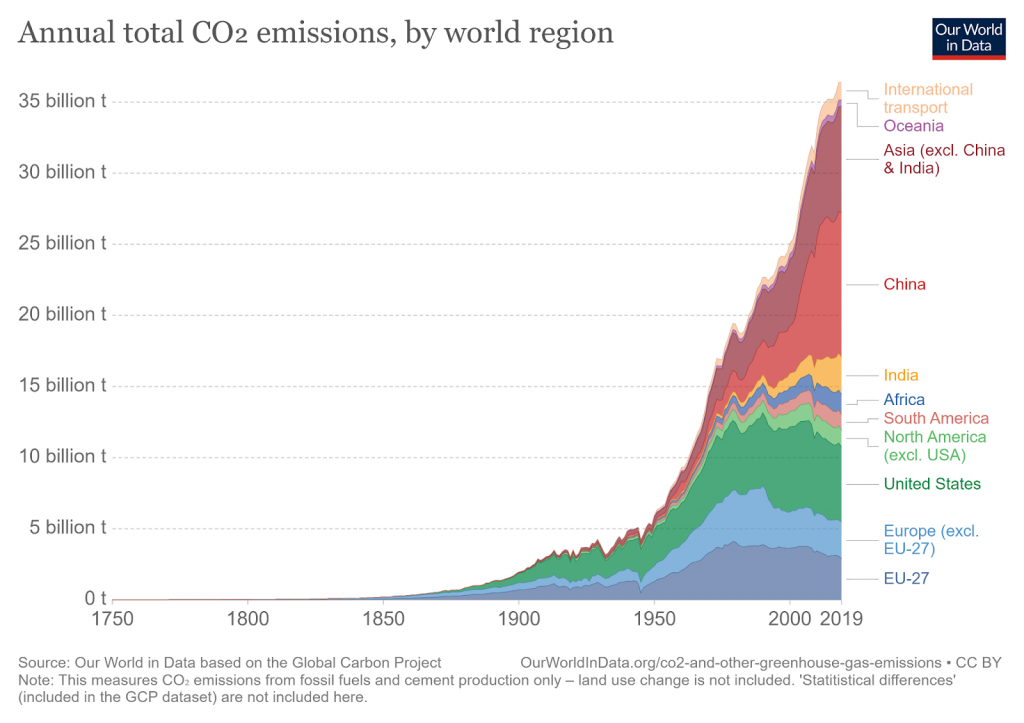
When you buy a carbon offset, you are paying someone else to cut their emissions so you don’t have to cut your own emissions. This is why offsetting alone will not be enough to reduce global carbon emissions.
Carbon offsets are a good place to start if you want to get into the carbon-emission reduction game, but in order to be effective in the long term, we must not rely on them solely. Cutting emissions from the source and then offsetting the remainder is the best way to reduce our carbon footprint and provide the highest environmental benefits. If we fail to cut emissions first, we will fill up our carbon sinks and render them unusable. Preventing carbon emissions rather than reacting once they are already emitted is the best way to reduce overall emissions.
Carbon offsets reduce GHG emissions from coal, oil, and natural gas. Reducing your consumption of these, in turn, reduces your carbon footprint, which has huge impacts on environmental, economic, and public health. A reduced carbon footprint due to lower GHG emissions can mitigate the effects of climate change, improve public health, boost the economy, and maintain plant and animal diversity.
- Climate change: Reducing your carbon footprint plays a role in mitigating the side effects of global climate change. The more we reduce the amount of GHG emissions, the more we slow the rate of temperature rise, sea-level rise, ice melting, and ocean acidification.
- Public health: Reducing GHG emissions lessens the likelihood and severity of extreme weather events, improves air and water quality, maintains biodiversity, and supports a healthy food supply.
- Economics: Reducing GHG boosts the economy, especially when it becomes economically rewarding to innovate solutions that help protect our planet, fight climate change, and are based on clean energy.
- Plant and animal diversity: Protecting biodiversity protects human health because many plants and animals are used in modern medicines
Carbon offsets have the potential to instigate meaningful environmental change, but to make the greatest impact we must understand both their benefits AND drawbacks.
Final Thoughts
The best carbon offsets for e-commerce in terms of overall impact are EcoCart, Cloverly, CO2ok, and ClimatePartner. In addition, Cooler locks away carbon permits from the compliance market, and Carbonfund specializes in offsetting shipping costs.
Because e-commerce is such a large industry, there is a great potential to reduce carbon emissions in this sector. Carbon offsets can help reduce your overall carbon emissions to balance off your personal carbon footprint to fight climate change – at least in the short term. But in the long term, direct methods of carbon footprint reduction are much more effective. We should be reducing our carbon footprint first before relying on e-commerce carbon offsets in order to make more of a difference in the fight against climate change.
Stay impactful,

Sources
- U.S. Environmental Protection Agency: Offsets and RECs -What’s the Difference?
- Britannica: Carbon Offset
- David Suzuki Foundation: Are carbon offsets the answer to climate-altering flights?
- Impactful Ninja: How to Buy Carbon Offsets That Actually Make a Difference (Complete 2022 Guide)
- Statista: eCommerce report 2021
- EcoCart: Homepage
- UTZ: Homepage
- BarkBox: Homepage
- EcoCart: The Most Impactful Carbon Offsetting Projects
- EcoCart: About Us
- EcoCart: How to Offer Carbon Neutral Orders
- EcoCart: Carbon Offsetting Project Browser
- United Nations: Climate Change
- Verra: Verified Carbon Standard
- Gold Standard: Gold Standard Impact
- American Carbon Registry: Homepage
- Climate Action Reserve: Homepage
- EcoCart: Affiliate
- Chrome Web Store: EcoCart – Carbon Neutral Shopping
- Cloverly: Homepage
- Cloverly: About Us
- Cloverly: Cloverly’s Carbon Offset Map
- Cloverly: FAQs
- Cloverly: Carbon Neutral Shipping for E-Commerce
- Cloverly: Contact Us
- Cloverly: A Carbon Offset Project With One API
- Cloverly: Carbon-Neutral Shipping App for Shopify
- Cloverly: Sustainable Shipping App for BigCommerce
- South Pole: Climate Click
- South Pole: Projects
- South Pole: Mission
- Shopify App Store: Climate Neutral Checkout
- WordPress: South Pole – Climate Action Now
- Magento: South Pole Climate Action for All
- Stripe: Homepage
- Stripe: Stripe Climate
- Frontier: Homepage
- Frontier: Our portfolio
- Frontier: Frontier Climate
- Stripe: Stripe Climate FAQs
- Stripe: Pricing & Fees
- Stripe: Stripe Dashboard
- Stripe: Contribute to Stripe Climate
- Co2nsensus: Homepage
- Co2nsensus: Carbon Neutral Shipping | Green Delivery
- Co2nsensus: Carbon offset projects
- Co2nsensus: Improved Cookstoves Offset Project
- Co2nsensus: Buyukduz Hydroelectric Powerplant – Turkey
- Co2nsensus: Weyerhaeuser’s Forest Plantation, Uruguay
- The Gold Standard: Homepage
- Verra: Verified Carbon Standard
- United Nations Department of Economic and Social Affairs: The 17 Goals
- Co2nsensus: Contact Us
- ClimatePartner: Homepage
- ClimatePartner: E-commerce
- ClimatePartner: Climate Map
- ClimatePartner: Contact
- Carbon Checkout: Homepage
- Shopify App Store: Balance by Carbon Checkout
- Carbon Checkout: Oaxaca Wind Power Complex
- Carbon Checkout: Saint Nikola Wind Farm
- Carbon Checkout: Crow Lake Wind Power Complex
- Carbon Checkout: Henrico County Landfill Gas Combustion Project
- Carbon Checkout: Greenwood Landfill Gas to Energy
- United Nations Framework Convention on Climate Change: The Clean Development Mechanism
- Carbon Checkout: FAQ
- Carbon Checkout: Contact
- Cooler: Homepage
- Cooler: Customers
- Cooler: Cooler FAQ
- Environmental Defense Fund: How cap and trade works
- Climate Vault: Homepage
- Impactful Ninja: How to Buy Carbon Offsets That Actually Make a Difference (Complete 2022 List)
- Cooler: How We Bill
- Cooler: BigCommerce
- Cooler: API
- Shopify App Store: Cooler
- One Tribe Global: Homepage
- One Tribe Global: About Us New – One Tribe
- One Tribe Global: Projects
- One Tribe Global: Pricing
- Rainforest Trust: Homepage
- Calendly: Select a Date and Time
- Green Story: SimpliZero ECommerce
- Green Story: Homepage
- Green Story: About
- Green Story: Offset your product carbon footprint with Simplizero Ecommerce
- Green Story: Book a Demo
- Carbonfund: Homepage
- Carbonfund: About Carbonfund.org
- Carbonfund: Carbon Offset Carbonfree Shipping Program
- Carbonfund: Energy Efficiency
- Carbonfund: Forestry
- Carbonfund: Renewable Energy
- Carbonfund: Carbonfund.org Foundation Project Maps
- Carbonfund: Contact the Carbonfund.org Foundation
- Natural Resources Defense Council: Carbon Offsets 101
- Terrapass: Project Standards
- Verra: Verified Carbon Standard
- Verra: Tepekisla Dam & Hydropower Plant Project
- Verra: The Jaguar Amazon Redd+ Project
- Verra: Sanya Landfill Gas Power Generation Project
- Gold Standard: Gold Standard Impact
- Climate Action Reserve: About Us
- Climate Action Reserve: Registry
- Climate Action Reserve: Bluesource – Berkeley County Landfill Gas Project
- Climate Action Reserve: Buckeye Forest Project
- American Carbon Registry: Our Mission
- American Carbon Registry: Registry
- American Carbon Registry: EOS Climate ODS destruction
- American Carbon Registry: Baker Mine AMM
- Impactful Ninja: What Are the Biggest Carbon Offsetting Limitations? (All 9 Explained)
- GreenPeace: The biggest problem with carbon offsetting is that it doesn’t really work
- International Energy Agency: After steep drop in early 2020, global carbon dioxide emissions have rebounded strongly
- Our World in Data: Annual total CO2 emissions
- Impactful Ninja: What Is the Carbon Footprint of Coal Energy? A Life-Cycle Assessment
- Impactful Ninja: What Is the Carbon Footprint of Oil Energy? A Life-Cycle Assessment
- Impactful Ninja: What Is the Carbon Footprint of Natural Gas? A Life-Cycle Assessment
- Impactful Ninja: 4 Main Reasons Why Reducing Your Carbon Footprint Is Important
- National Wildlife Federation: Climate Change
- National Institute of Environmental Health Sciences: Health Impacts of Climate
- Carbon Tax Center: What’s a Carbon Tax?
- World Health Organization: Biodiversity and Health
- Impactful Ninja: Can You Really Offset Your Carbon Footprint? Here Are the Facts







